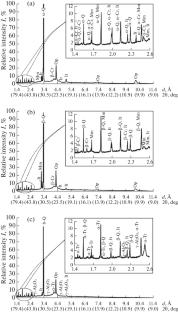坦波夫州克拉斯诺洛博斯克矿床活化的黎波里的x射线光谱分析
IF 0.5
Q4 MATERIALS SCIENCE, MULTIDISCIPLINARY
引用次数: 0
摘要
建立了黎波里热活化过程中造岩矿物组成变化的特征。在T >500℃,粘土矿物分解,形成氧化铝的高温改性。在200 ~ 500℃的温度范围内,非晶态蛋白石-方石英结构的有序度随着方石英的相变而提高;温度的进一步升高使其转变为三钇石。本文章由计算机程序翻译,如有差异,请以英文原文为准。

X-Ray Spectrometry of Activated Tripoli in the Krasnoslobodsk Deposit of Tambov Oblast
The features of the changing composition in rock-forming minerals during thermal activation of tripoli are established. At T > 500°C, clay minerals are decomposed, and high-temperature modification of aluminum oxide is formed. In the temperature range of 200–500°C, the ordering of the amorphous opal-cristobalite structure grows owing to the phase changes in cristobalite; the further rise in the temperature leads to its transformation to tridymite.
求助全文
通过发布文献求助,成功后即可免费获取论文全文。
去求助
来源期刊

Inorganic Materials: Applied Research
Engineering-Engineering (all)
CiteScore
0.90
自引率
0.00%
发文量
199
期刊介绍:
Inorganic Materials: Applied Research contains translations of research articles devoted to applied aspects of inorganic materials. Best articles are selected from four Russian periodicals: Materialovedenie, Perspektivnye Materialy, Fizika i Khimiya Obrabotki Materialov, and Voprosy Materialovedeniya and translated into English. The journal reports recent achievements in materials science: physical and chemical bases of materials science; effects of synergism in composite materials; computer simulations; creation of new materials (including carbon-based materials and ceramics, semiconductors, superconductors, composite materials, polymers, materials for nuclear engineering, materials for aircraft and space engineering, materials for quantum electronics, materials for electronics and optoelectronics, materials for nuclear and thermonuclear power engineering, radiation-hardened materials, materials for use in medicine, etc.); analytical techniques; structure–property relationships; nanostructures and nanotechnologies; advanced technologies; use of hydrogen in structural materials; and economic and environmental issues. The journal also considers engineering issues of materials processing with plasma, high-gradient crystallization, laser technology, and ultrasonic technology. Currently the journal does not accept direct submissions, but submissions to one of the source journals is possible.
 求助内容:
求助内容: 应助结果提醒方式:
应助结果提醒方式:


